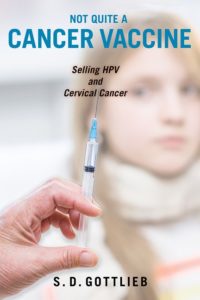Reviewed Book
Not Quite a Cancer Vaccine: Selling HPV and Cervical Cancer. S. D. Gottlieb, New Brunswick, NJ: Rutgers University Press, 2018, 200 pp.

S. D. Gottlieb’s title, which indexes uncertainty (“not quite a cancer vaccine”), accurately describes the book’s attention to the fraught public responses to international pharmaceutical company Merck’s marketing of Gardasil in the United States. The vaccine prevents recipients from contracting certain strains of human papilloma virus (HPV), which most notably leads to cervical cancer but can also cause cancers in other parts of the body. Since its approval by the Food and Drug Administration in 2006, Gardasil has been the subject of social science critiques, particularly around its framing of female adolescent sexuality (e.g., Casper and Carpenter 2008). Gottlieb expands on these critiques to outline the ways in which Merck downplayed the role of the vaccine as a prophylactic for sexually transmitted infections (STIs) and instead highlighted its role in preventing cervical cancer.
Pointing to the anticipatory logics of the vaccine, Gottlieb describes how Merck’s marketing efforts led to low rates of Gardasil utilization in the United States and globally. Gottlieb’s claim is that the focus on the vaccine’s potential to prevent cervical cancer produced distrust and unease among key stakeholder groups by presenting it as “the only real solution to the (hyped) threat of cervical cancer” (p. 137). Noting the invisibilities in the marketing of Gardasil, the book brings topics out of the shadows, demonstrating how marketing messages obscure structural vulnerabilities (e.g., lack of access to preventive cervical cancer care such as Pap smears), true public awareness about HPV, and the near ubiquity of infection through sexual transmission. Gottlieb notes that women who have high rates of cervical cancer are also less likely to have access to Pap smears, which have been effective in reducing deaths from cancer in the United States . Moreover, Gottlieb’s research suggests that parents do not see the value of preventing HPV infection in their children (boys and girls) because the danger of vaccination overshadows a cancer that is successfully managed by regular Pap smears for much of the U.S. population of women.
In Gottlieb’s ethnography, Gardasil is the focus, rather than a specific community of people. This approach is common in science and technology studies but less so among anthropological ethnographers. A multi-sited approach took Gottlieb to Food and Drug Administration (FDA) hearings, community meetings, low-income health clinics, and scientific conferences across the United States, although much of her work seems to have taken place in California. The author does an admirable job of tracing the interactions in Merck’s marketing of Gardasil, outlining the process of biomedicalization among various stakeholders engaged in managing their children’s vaccinations (mothers), attending to the care of their patients (health care providers), and advocating for better health care and cancer awareness (community advocates). These stakeholders are part of complex political economies, a fact that Gottlieb’s analysis touches on but does not address in depth.
The chapters briefly walk the reader through Gardasil’s FDA fast-track review, while examining how Merck’s marketing and lobbying activities served to empower certain social groups and alienate others. Gottlieb provides a necessarily partial view of various community and clinical contexts in the book’s nine chapters. Showing evidence of how Merck’s Gardasil messaging permeated these contexts, Gottlieb critiques their appropriation by cervical cancer advocacy groups and physicians. The book provides evidence that Merck’s efforts to educate medical professionals through continuing medical education sessions influenced physician practices and communication to their patients, spreading the message that Gardasil was a cancer vaccine rather than an STI prophylactic.
Gottlieb also includes chapters highlighting social groups that challenged the vaccine’s utility, particularly advocates for the health of women of color and mothers who self-identify as selective- or slow-vaccinators. Importantly, the book contrasts the apolitical awareness-raising approach of an advocacy group called the Cervical Cancer Group, which accepted Merck financial support, and messaging by the Black Women’s Health Group, which “eyed the Merck ads warily” (p. 101). Gottlieb briefly examines the historical distrust of biomedicine among women of color, noting that women of color have higher rates of cervical cancer than the general U.S. population.
Because of this multi-sited approach, I found myself grasping for a narrative thread, which the chapter organization does not provide. While untethering the reader can be a useful literary method, in this case, I fear it obscured the author’s main point: that Merck’s marketing approach alienated its target population as well as historically marginalized women of color who might find some benefit in the vaccine. While I occasionally lost my way in this book, the story Gottlieb tells is engaging, complicated, and multilayered. I recommend this book as a companion to other social science literature that can provide a more complete view of global disparities in cervical cancer, the political economy of the pharmaceutical industry, cancer advocacy, and vaccine social movements.
As a cornerstone book for an undergraduate anthropology course focused on science and technology studies, Not Quite a Cancer Vaccine is an accessible volume that provides a framework for elucidating the processes of biomedicalization. Paired with social movements and public/global health-oriented ethnographic literature, it has the potential to deepen students’ knowledge of the historical particularity of the production of Gardasil, as well as an understanding of what is at stake in the production of biomedical identities.
Reference Cited
Casper, M. J., and L. M. Carpenter. 2008. Sex, Drugs, and Politics: The HPV Vaccine for Cervical Cancer. Sociology of Health & Illness 30: 886–99.